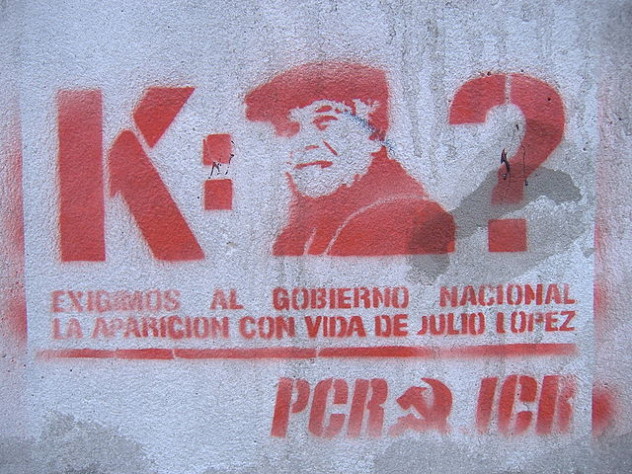 Technology
Technology  Technology
Technology  Humans
Humans 10 Everyday Human Behaviors That Are Actually Survival Instincts
 Animals
Animals 10 Animals That Humiliated and Harmed Historical Leaders
 History
History 10 Most Influential Protests in Modern History
 Creepy
Creepy 10 More Representations of Death from Myth, Legend, and Folktale
 Technology
Technology 10 Scientific Breakthroughs of 2025 That’ll Change Everything
 Our World
Our World 10 Ways Icelandic Culture Makes Other Countries Look Boring
 Misconceptions
Misconceptions 10 Common Misconceptions About the Victorian Era
 Mysteries
Mysteries 10 Strange Unexplained Mysteries of 2025
 Miscellaneous
Miscellaneous 10 of History’s Most Bell-Ringing Finishing Moves
 Technology
Technology Top 10 Everyday Tech Buzzwords That Hide a Darker Past
 Humans
Humans 10 Everyday Human Behaviors That Are Actually Survival Instincts
 Animals
Animals 10 Animals That Humiliated and Harmed Historical Leaders
Who's Behind Listverse?

Jamie Frater
Head Editor
Jamie founded Listverse due to an insatiable desire to share fascinating, obscure, and bizarre facts. He has been a guest speaker on numerous national radio and television stations and is a five time published author.
More About Us History
History 10 Most Influential Protests in Modern History
 Creepy
Creepy 10 More Representations of Death from Myth, Legend, and Folktale
 Technology
Technology 10 Scientific Breakthroughs of 2025 That’ll Change Everything
 Our World
Our World 10 Ways Icelandic Culture Makes Other Countries Look Boring
 Misconceptions
Misconceptions 10 Common Misconceptions About the Victorian Era
 Mysteries
Mysteries 10 Strange Unexplained Mysteries of 2025
 Miscellaneous
Miscellaneous 10 of History’s Most Bell-Ringing Finishing Moves
10 Witnesses Who Came To Tragic Ends
It can be extremely stressful for a person to testify in court as a witness against a dangerous criminal. In that situation, doing the right thing can easily put someone’s life in jeopardy. In the most extreme cases, it can force them to start a new life under a new identity through a witness protection program. But sadly, some witnesses never make it that far and become missing persons or the victims of unsolved murders.
10 The Disappearances Of Michael Mansfield And Ruth Martin

During one six-month period in 1975, two different witnesses vanished before they were scheduled to testify against the same person in different cases. What’s particularly horrific about this story is that they lost their lives for witnessing relatively minor crimes.
Nineteen-year-old Michael Mansfield was a student at Lincoln College in Illinois. His roommate was a fellow student named Russell Smrekar. However, Smrekar was expelled from the school after being charged with burglary for stealing a guitar and some record albums from a dorm room. Smrekar allegedly gave the albums to Mansfield. To avoid being charged with possession of stolen property, Mansfield agreed to testify against him. On New Year’s Eve, Mansfield was spending the holidays at his parents’ house when he told them he was leaving to visit a friend. Mansfield never returned, and the burglary charge against Smrekar was subsequently dropped.
Shortly thereafter, Smrekar was charged with stealing three steaks worth a total of $4 from a Lincoln grocery store. The witnesses scheduled to testify against Smrekar were Jay Fry, the produce manager, and a woman named Ruth Martin who witnessed Smrekar tossing the steaks into his car. On June 2, 1976, Martin disappeared. Her abandoned car was subsequently found with blood inside. Three months later, Smrekar broke into Jay Fry’s home and shot both him and his pregnant wife to death.
Smrekar was convicted of their murders and sentenced to 300 years in prison. The fates of Michael Mansfield and Ruth Martin remained unknown until October 2011 when Smrekar became terminally ill and made a deathbed confession to their murders. While the bodies of Mansfield and Martin have never been found, it’s likely that four innocent people were senselessly murdered over some small-time theft.
9 The Disappearance Of Oliver Munson

In January 1983, a Baltimore schoolteacher named Oliver Munson bought a used vehicle from a man named Dennis Watson. Two months later, police showed up at Munson’s door and delivered some surprising news: The car he purchased was a stolen vehicle. It turned out that Dennis Watson was the leader of an auto theft ring that had just been raided by the authorities. Munson had no idea he had purchased a stolen vehicle and agreed to testify against Watson.
On the morning of February 13, 1984, three days before Munson was scheduled to testify, he left his home in Catonsville to drive to his school. He never showed up and has not been seen since.
Three days after Munson disappeared, his abandoned car was discovered two blocks from his home with a flat tire. Eleven days after that, a stolen vehicle was discovered near Leakin Park with traces of blood and a spent cartridge casing inside. The car also contained two video store receipts with Munson’s name on them, leading to speculation that he had been abducted and murdered to prevent him from testifying.
Dennis Watson already had a very shady history with witnesses. In 1973, a witness named Clinton Glenn was killed before he could testify against Watson in an armed robbery case. Watson was subsequently charged with Glenn’s murder, but those charges were dropped after the prime witness against him in that case died of a drug overdose. In spite of Munson’s disappearance, Watson still pleaded guilty to auto theft and received a 10-year sentence. Watson was paroled in 1989, but Oliver Munson has never been found.
8 The Murder Of Tammy Vincent

On September 26, 1979, the burned body of an unidentified Jane Doe was discovered on a beach in Tiburon, California. She had been beaten, shot in the head, and stabbed 43 times before her body was doused with acetone and set on fire. Because of the condition of her body, she could not be identified for nearly 30 years. There was some suspicion that she might have been a victim of Gary Ridgway, the notorious Green River Killer.
In 2007, DNA testing positively identified her as Tammy Vincent, a missing 17-year-old runaway from Seattle. Shortly before her death, Tammy had called her sister from California and expressed a desire to come home and claimed she was in fear for her life.
In August 1979, police raided a Seattle apartment that was being used as a front for a prostitution ring. They found Tammy, who had been working a prostitute. She was sent to Spokane to stay with the Department of Social and Health Services until she ran away. Two weeks before her murder, Tammy was seen at a Seattle motel, getting into a vehicle owned by one of the suspects in the investigation. The following day, Tammy was subpoenaed as a witness to testify against five men who were charged with prostitution and racketeering, but she never showed up.
The defendants in the case received varying prison sentences over the next few years. The night before Tammy’s murder, a girl who resembled her was seen in a San Francisco store alongside a man who bought an ice pick and some acetone. This man is presumed to be Tammy Vincent’s killer, but he has never been identified and the case remains unsolved.
7 The Disappearance Of Jorge Julio Lopez

In 1976, Argentina underwent a political coup d’etat. For the next seven years, the country was ruled by a right-wing military dictatorship. During that time, an estimated 30,000 people were the victims of forced disappearances and illegal arrests. One of these victims was a bricklayer and labor activist named Jorge Julio Lopez, who was held without charges and tortured in a police detention center from 1976 to 1979.
After democracy was restored to Argentina in 1983, amnesty laws prevented the prosecution of government officials for these crimes. It wasn’t until 2005 that the Supreme Court ruled the amnesty laws to be unconstitutional and investigations were reopened. It wasn’t long before Miguel Etchecolaz, the Buenos Aires Province police commissioner who oversaw the detention center, was charged with numerous crimes, including homicide.
One of the key witnesses at Etchecolaz’s trial would have been 76-year-old Jorge Julio Lopez, who was tortured by Etchecolaz and personally witnessed the former commissioner execute five people during his time in captivity. On September 18, 2006, Lopez left his home in La Plata and was headed to the tribunal courts to deliver his final testimony against Etchecolaz, but he never arrived.
Initially, it was theorized that recounting his torturous experiences at trial had caused Lopez to suffer a nervous breakdown, possibly causing him to became disoriented or wander off to commit suicide. However, rumors started circulating that loyal members of the provincial police force who served under Etchecolaz orchestrated Lopez’s disappearance. Nevertheless, even without Lopez’s final testimony, Miguel Etchecolaz still received a life sentence for his crimes. The government faced heavy criticism for its lack of witness protection procedures. In spite of the substantial reward offered for Lopez’s return, he has still never been found.
6 The Disappearance Of Angie Tucker
In October 2007, 33-year-old Tulsa resident Angie Tucker went to the police to file charges against her ex-boyfriend, Allen Shields, accusing him of breaking into her apartment and raping her. Shields was charged with burglary and rape, but he claimed the sex was consensual and was released on bond. Tucker filed a restraining order against her former boyfriend and was scheduled to testify against him in court.
On the evening of November 3, Tucker was staying at her mother’s house with her children when she left to go buy some cigarettes. Tucker never returned and has not been seen since. Without Tucker’s testimony, the charges against Shields had to be dropped, but he would continue to have troubles with the law.
In 2010, Shields was charged with breaking into the home of another ex-girlfriend and attacking her. He was subsequently sentenced to house arrest. Shortly thereafter, Shields and four other men were indicted in the 2008 murder of a businessman named Neal Sweeney. Shields agreed to testify against the other conspirators in exchange for 10 years’ probation.
Believe it or not, Shields would soon be implicated in another 2008 murder, this time involving a man named Frederick Anthony Wilson. A DNA sample was taken from him. In April 2011, before the Wilson murder could be resolved, Shields found himself in a standoff with police after breaking into the home of the same ex-girlfriend he had attacked the year before. Shields took the woman’s young daughter hostage, but after letting the girl go, he committed suicide by shooting himself. Unfortunately, if Shields had any involvement in the unsolved disappearance of Angie Tucker, he took that secret to his grave.
5 The Murder Of Franklin Freeman

During the day, Franklin Freeman worked at a pet salon in Charlotte, North Carolina. But at night, Freeman performed in gay nightclubs as a drag queen named Aretha Scott and became a popular figure in the community. However, Freeman was also known for turning tricks under his Aretha Scott persona.
In the early morning hours of January 8, 2002, a vice cop named Michael Marlow finished his shift at the Charlotte-Mecklenburg police station and joined his fellow officers for a drinking party in the parking deck. The intoxicated Marlow then drove to a nearby neighborhood and picked up Franklin. An argument ensued, Marlow fired his gun at Franklin, and Franklin was arrested and jailed for assaulting an officer.
According to Marlow, he picked up Franklin after seeing him wave for help and only fired his weapon after Franklin assaulted him. Franklin’s story was that Marlow picked him up willingly and fired the gun after a dispute over a $20 payment. Prosecutors ultimately believed Franklin’s version of events and dropped the charges against him. Marlow promptly resigned from the force, and all the officers involved in Franklin’s arrest were either suspended or fired.
Months after the incident, Franklin was scheduled to testify at a hearing for Marlow’s supervising officer, who was appealing his suspension. On the evening of June 2, five days before his testimony, Franklin was found unconscious on a sidewalk. He had been shot in the left leg, which lacerated his femoral artery. Before Franklin could get proper medical attention, he bled to death. The authorities have faced criticism for not properly investigating Freeman’s murder, as many people feel it was connected to his upcoming testimony. Whatever the truth, Franklin Freeman’s death remains unsolved after 13 years.
4 The Disappearance Of Henry Baltimore Jr.
In 1973, 21-year-old Henry Baltimore Jr. had a very promising future. He was an honor student at the University of Michigan and a drum major in the school’s marching band. However, in March 1973, Henry’s future would be seriously compromised after he was attacked by two men in his apartment, who proceeded to tie him to a bed before stealing $110 and some items. Even though Henry was reluctant to report this incident to the police, he finally did so at his father’s urging.
A suspect named Roy Davis was soon arrested for participating in the attack and charged with armed robbery. Henry was scheduled to testify at Davis’s preliminary hearing but did not show up. He resurfaced two days later and asked police to drop the case against Davis because he was frightened. The cops refused, and Henry’s testimony was rescheduled.
On May 30, two days before Henry was set to testify at Davis’ arraignment, he mysteriously disappeared. According to his roommates, Henry had left his apartment to go to the library but never returned. In spite of the obvious suspicions about Davis, his mother provided him with an alibi during the time period Henry went missing, and no evidence was ever found to tie Davis to the disappearance. Because of Henry’s absence, prosecutors ultimately decided to offer Davis a deal to plead guilty to lesser charges, and he received a six-month sentence. Authorities initially suspected that Henry had gone into hiding to avoid testifying, but even after Davis went to jail, Henry did not resurface. He has not been seen for over 40 years.
3 The Disappearance Of Kelsey Collins

After experiencing a turbulent childhood where she was subject to violent abuse from her stepfather, Kelsey Collins’s troubled lifestyle continued once she reached her teens. At the age of 12, she was already running away from home, becoming sexually active, and using drugs. Kelsey eventually became involved with an older man who forced her into prostitution and acted as her pimp. Finally, in January 2008, the 16-year-old Kelsey was picked up for prostitution in Portland, Oregon, and agreed to help the authorities in their ongoing investigation against her pimp boyfriend.
After Kelsey testified against the pimp in front of a federal grand jury, he was charged with interstate sex trafficking of a minor. On May 9, 2009, one month after her testimony, Kelsey left her mother’s home in Everett, Washington, allegedly to take the bus to Seattle to visit a new boyfriend. She never returned home. Without further testimony from Kelsey, the case against her pimp fell apart and the charges against him were subsequently dropped. Nonetheless, the pimp would be charged with prostituting another 14-year-old girl three months later and is currently serving a 15-year prison sentence. No one knows for sure if Kelsey’s disappearance had any connection to her testimony, but she has never resurfaced.
2 The Murder Of Warren G. Hooper

During the 1940s, political corruption was rampant in the state of Michigan, and it was not uncommon for politicians and legislators to accept bribes in exchange for their votes. After 40-year-old Republican State Senator Warren G. Hooper confessed to receiving a $500 bribe for his vote on a horse racing bill, he was offered immunity to testify as a witness in front of a grand jury on legislative bribery. On January 11, 1945, four days before he was scheduled to testify, Hooper was driving from Lansing to his home in Albion. His burning car was later discovered on the side of the road outside the town of Springport. Hooper’s body was found in the front seat with three bullets in his head.
Curiously, two more witnesses who were involved in the same grand jury investigation would soon be found dead under suspicious circumstances. The investigation eventually turned toward former members of the Purple Hill Gang, an organized crime faction who controlled Detroit during the 1920s and ’30s. Rumors began circulating that former state treasurer Frank McKay, who was being investigated by the grand jury, orchestrated Hooper’s murder. It was alleged that two imprisoned Purple Hill Gang leaders bribed a deputy warden to temporarily release them from Michigan State Prison. After ambushing Hooper, they promptly returned to the prison to establish a seemingly ironclad alibi.
Four former Purple Hill Gang members were eventually charged with conspiracy to commit murder on the testimony of a career criminal who claimed the defendants once approached him to kill Hooper. While all four defendants were convicted, their sentences were short, and one of the convictions was later overturned. The full extent of the plot to murder Warren G. Hooper was never conclusively established.
1 The Disappearances Of Rachel And Shannon Timmerman
In August 1996, 19-year-old Cedar Springs, Michigan, resident Rachel Timmerman went to the police after being raped by a man named Marvin Gabrion, who was subsequently charged with the crime and released on bond. The prime evidence against Gabrion would be Rachel’s testimony, along with corroborating testimony from a witness named Wayne Davis. However, in February 1997, Davis disappeared. On June 3, two days before the start of Gabrion’s trial, Rachel left her father’s home with her 11-month-old daughter, Shannon. Rachel claimed she was being picked up for a date by a friend named John Weeks. This would be the last time Rachel and Shannon were seen alive.
On July 5, Rachel’s body was found in Oxford Lake. She had been chained to cinder blocks and throw into the water to drown. Gabrion was eventually tracked down and charged with Rachel’s murder. Shannon was never found, and Gabrion never revealed what happened to her. Since John Weeks also went missing without a trace, it was theorized that Gabrion used him to lure Rachel and Shannon to their deaths before killing him, too.
Gabrion also became the prime suspect in the unrelated disappearance of a transient named Robert Allen after he was charged with using Allen’s identity to commit Social Security fraud. In March 2002, Gabrion was convicted of Rachel’s murder and sentenced to death. On July 5 of the same year, exactly five years after Rachel was found under similar circumstances, Wayne Davis’s body was discovered in a lake, chained to cinder blocks.
Gabrion is currently on death row. While he is also believed to be responsible for the murders of Wayne Davis, John Weeks, Robert Allen, and Shannon Timmerman, those cases officially remain unsolved.
Robin Warder is a budding Canadian screenwriter who has used his encyclopedic movie knowledge to publish numerous articles at Cracked.com. He is also the co-owner of a pop culture website called The Back Row and recently wrote the award-winning script for a short film called Indefinite Late Fee. Feel free to contact him here.








